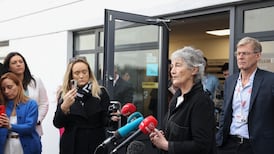The recent RTÉ documentary on the deaths of babies at the Midland General Hospital in Portlaoise points to the worrying pattern of the Health Service Executive (HSE) failing to implement its own reports.
On the surface, it suggests at least one couple’s baby might still be alive if failures identified in a previous case had been addressed.
Mark Molloy was born at the hospital in January 2012. He was alive at the onset of labour, but died shortly after being born. Four babies died either during labour or within seven days of birth. A common denominator in all four deaths was the presence of anoxia – oxygen starvation to the baby’s brains.
According to the Prime Time report, some of the babies died because of a failure to act on signs of foetal distress. Staff were either too busy to adequately monitor the cardiotocograph (CTG) recordings or a health professional misinterpreted an abnormal reading as a normal finding. (A CTG records both maternal contractions and the baby's heart beat).
The discovery of two warning letters from all 32 midwifery staff at the maternity unit, before the first death in 2008, suggests the facility may have been under-resourced.
An investigation into Mark Molloy’s death found that recommendations made following the death of another baby at Portlaoise in almost identical circumstances two years previously had not been implemented.
Missed chance
It echoes a similar missed chance to prevent a future fatality identified in the recent report into the death of Savita Halappanavar following a miscarriage at University Hospital Galway. In her case it emerged that national recommendations for safer care contained in the report into the death of pregnant Drogheda woman Tanya McCabe had not been adequately followed up.
While the track record of HSE failure to implement the findings of important investigations into critical incidents has been irrefutably established, a re-examination of previous reports and recommendations suggests it may be unfair to ask the agency to shoulder all the blame for ongoing patient safety failures.
In 2009, a Hiqa report recommended services at Ennis hospital should be reconfigured, that it was unsafe to retain them as they were.
It carried out its report after the deaths of cancer patients Edel Kelly and Ann Moriarty. This was the beginning of an effort to reconfigure Irish hospitals to make them safer for patients. The Acute Medicine Programme published in 2010 recommended the creation of a four-tier hospital system. Model 2 hospitals would essentially cease providing 24-hour emergency care, including full-scale surgical and obstetric services.
Instead, their capacity to carry out elective surgery and day-case investigations was to be significantly ramped up. Roscommon hospital is an example where this is successfully taking place.
In February of last year, the Department of Health published a document,Securing the Future of smaller hospitals: a framework for development, that named nine smaller hospitals which it said had "been the subject of particular attention from the Hiqa".
They included Navan, Loughlinstown, Mallow, Ennis, Nenagh and Roscommon. These hospitals were to become Model 2 hospitals, the document stated. A glaring omission from the list was the Midland General at Portlaoise. It has been clear from Hiqa reports since the 2009 Ennis inquiry that hospitals of the size and status of Portlaoise needed to be reconfigured.
Who was responsible?
So the question arises: who was responsible for removing a facility that Hiqa and various professional bodies signalled should have been on the Model 2 list? Was it because of lobbying by local representatives of the Minister for Health? Did James Reilly, as is his right, unilaterally and without lobbying, decide that he did not agree with the Portlaoise recommendation?
The parents of Mark Molloy and the other children who died in an apparently under-resourced Midland General are owed a comprehensive answer. Those of us who care deeply about patient safety would also welcome an explanation.
mhouston@irishtimes.com
muirishouston.com









